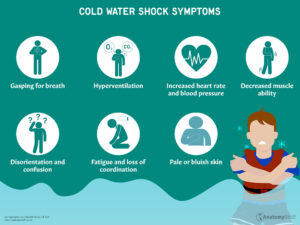
Cold water shock, also known as immersion or cold shock response, refers to the physiological and psychological reactions that occur when a person suddenly enters cold water (defined as under 15°C). It’s a natural and involuntary body response to abrupt change in temperature, and it can have serious consequences, including drowning.
When you are exposed to cold water, several immediate reflexes are triggered by your body in an attempt to adapt to the sudden change. These automatic actions include gasping for breath, hyperventilation, increased heart rate and blood pressure, and narrowing blood vessels (peripheral vasoconstriction). These responses can happen within seconds of entering the cold water and can be dangerous, leading to panic, disorientation, and a loss of physical ability.
The gasping reflex, in particular, is a major concern during cold water immersion. When your body is suddenly exposed to cold water, the reflex can cause an involuntary intake of breath, leading to water inhalation. This puts you at risk of drowning, especially if you are not wearing a life jacket or cannot stay afloat.
• Gasping for breath
• Hyperventilation
• Increased heart rate and blood pressure
• Decreased muscle ability
• Disorientation and confusion
• Fatigue and loss of coordination
• Pale or bluish skin

To reduce the risks associated with cold water shock, here are nine crucial tips:
• Be aware of water temperature – always check the water temperature before entering. Cold water shock can occur even in relatively mild temperatures, so knowing what you’re getting into is essential.
• If you plan to swim or participate in water activities, gradually acclimatise your body to the water temperature. You should enter the water slowly, allowing your body to gradually adjust to the temperature changes more effectively.
• Wear appropriate clothing – wear a wetsuit or other suitable cold-water gear when engaging in water activities. This can provide some insulation and help to reduce the shock to your body.
• Control your breathing – when exposed to cold water, the initial shock can cause gasping and hyperventilation. Focus on controlling your breathing and avoid taking deep, sudden breaths. Try to take slow, controlled breaths to prevent inhaling water.
• Stay calm – if you find yourself in cold water shock, try to stay calm. Panic can worsen the situation. Focus on controlling your breathing and keeping your head above water.
• Learn to float – if you’re not a strong swimmer or become tired easily in cold water, learning to float on your back can be a valuable skill. This saves energy and gives you time to recover and call for help if needed.
• Swim with others – whenever possible, swim or engage in water activities with others. Having someone nearby can help and increase your safety in case of an emergency.
• Don’t drink alcohol before swimming – avoid consuming alcohol as it impairs judgment and reduces your ability to respond effectively to cold water shock.
• Seek professional instruction – if you plan to engage in water activities in cold conditions, consider taking swimming lessons or seeking professional instruction on cold water safety. They can provide specific guidance and techniques to minimise the risks associated with cold water shock.
Knowing what to do and how to best prepare for safe water activities gives you the best chance of remaining safe. Take the time this summer to read how to keep safe in cold water and enjoy the coast and rivers while respecting their power. For more informationa and safety tips please visit the RNLI’s website.